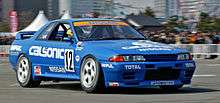Japanese Touring Car Championship
The Japanese Touring Car Championship (abbr: 1985–1993: JTC, 1994–1998: JTCC, officially known as All Japan Touring Car Championship, Japanese name: 全日本ツーリングカー選手権), was a former touring car racing series held in Japan. The series was held under various regulations during its existence, including international categories such as Group A and Super Touring, which allowed both Japanese and foreign built cars to compete. The final edition of the championship was held in 1998, although a failed attempt at a relaunch was planned for 2012.[1][2] A relaunched series, the TCR Japan Touring Car Series, began in 2019, using TCR regulations.
History

The series has a history from the late 1960s and was dominated by the C10 Skyline GT-Rs until the Mazda Savanna RX-3 broke its dominance pattern. With by the emergence of Group 5 cars in the later half of the 1970s, the series was replaced in 1979 by the Super Silhouettes, which was held as a support race to the Fuji Grand Champion Series. The series was incorporated and then later dissolved in 1984 by the All Japan Sports Prototype Championship.
The series saw a revival in 1985 for Group A cars, like all other championships in other countries, there was three divisions, by the late 1980s division 3 would be a closely fought competitions between Toyota Supras, Nissan Skylines and the European Ford Sierra RS500, whilst division 2 was mainly BMW M3s and division 1 was between Honda Civic and Toyota Corolla. Their biggest race of the season was the InterTEC 500 km which took place in Fuji Speedway in November, which often attracted the top teams and drivers from the European and Australian championships. Top touring car drivers such as Tom Walkinshaw, Peter Brock, Allan Moffat, Allan Grice and Klaus Niedzwiedz often travelled to Fuji for the race.
By 1993, like many other Group A series, the series had ended up becoming a one make affair with just the GT-R appearing on the top category (which had maintained a four-year undefeated streak), followed by the M3s on the other, whereas the JTC-3 division only consists of Corollas and Civics. For the following year the series would switch to the Supertouring formula. The cars entered by Japan's big three manufacturers for the then-new formula were initially the Nissan Primera, Honda Civic Ferio and Accord, and Toyota Corona. By 1997 as the Class II formula cars became more expensive and complicated - a problem that started to plague international series using the ruleset - and due to heavy competition from JGTC, organisers would make change to the rules to suit crowd demands. Rule changes includes increases to body width (allowing Toyota to use the larger Toyota Chaser) and exhaust noise decibels, as well as restrictions on front aerodynamic devices.
In 1998, the withdrawal of Nissan due to financial problems and Honda, to concentrate on its Formula One program (at the time an engine supply operation by Mugen Motorsports) and also realising it would be less expensive for them to race their NSX in the Japanese Grand Touring Championship series (although both Nissan and Honda did take part in British Touring Car Championship after leaving JTCC; those programs, however, were run by their European branches), left Toyota as the sole factory manufacturer to have cars competing using their Corona EXIVs and Chasers. Occasionally, a pair of independently run Subaru Impreza wagons did race against the factory Toyotas. In 1999, a new formula using spaceframe cars, now renamed Super Silhouette Car Championship came to nothing and the series was abandoned altogether as by then, the Japan's big three had all got work entries in JGTC to this day, now known as Super GT.
The JTCC was to be resurrected in 2013, with Super 2000 car regulations and a calendar consisting of five races in Japan and one in China, in partnership with the Chinese Touring Car Championship. The series had originally planned to return in 2012, but this was indefinitely delayed due to Tōhoku earthquake and tsunami that occurred earlier, and it was never heard around since 2014.[1] Touring car racing ultimately returned to Japan with the TCR Japan Touring Car Series in 2019, under TCR regulations and as support to Super Formula[3]; TCR cars had been previously allowed to race in Super Taikyu Series in 2017.[4]
During the championship's life, one fatal accident occurred: Akira Hagiwara was killed in a 1986 Sportsland SUGO race.
Championship winners
| Year | Winner | Team | Car | |
|---|---|---|---|---|
| Group A | ||||
| 1985 | Beaurex | BMW 635CSi | ||
| 1986 | NISMO | Nissan Skyline RS | ||
| 1987 | Object T | Ford Sierra RS Cosworth, Ford Sierra RS500 | ||
| 1988 | Object T | Ford Sierra RS Cosworth, Ford Sierra RS500 | ||
| 1989 | Hasemi | Nissan HR31 Skyline GTS-R | ||
| 1990 | Impul | Nissan BNR32 Skyline GT-R | ||
| 1991 | Hasemi | Nissan BNR32 Skyline GT-R | ||
| 1992 | Hasemi | Nissan BNR32 Skyline GT-R | ||
| 1993 | Impul | Nissan BNR32 Skyline GT-R | ||
| Supertouring | ||||
| 1994 | TOM'S | Toyota Corona E | ||
| 1995 | Schnitzer | BMW 318i | ||
| 1996 | Mooncraft | Honda Accord | ||
| 1997 | Mugen | Honda Accord | ||
| 1998 | TOM'S | Toyota Chaser | ||
See also
References
- Meissner, Johann (2010-08-01). "Japanese S2000 championship to be launched 2012". touringcartimes.com. MediaEmpire Stockholm AB. Archived from the original on 2012-03-23. Retrieved 2010-08-01.
- Meissner, Johann (2011-12-22). "JTCC launch postponed by one year". touringcartimes.com. MediaEmpire Stockholm AB. Archived from the original on 2013-02-04. Retrieved 2011-12-22.
- "TCR Japan set for launch in 2019 - TouringCarTimes". TouringCarTimes. 2018-10-17. Retrieved 2018-10-27.
- fabio. "Super Taikyu launches a class for TCR cars". www.tcr-series.com. Retrieved 2017-03-31.